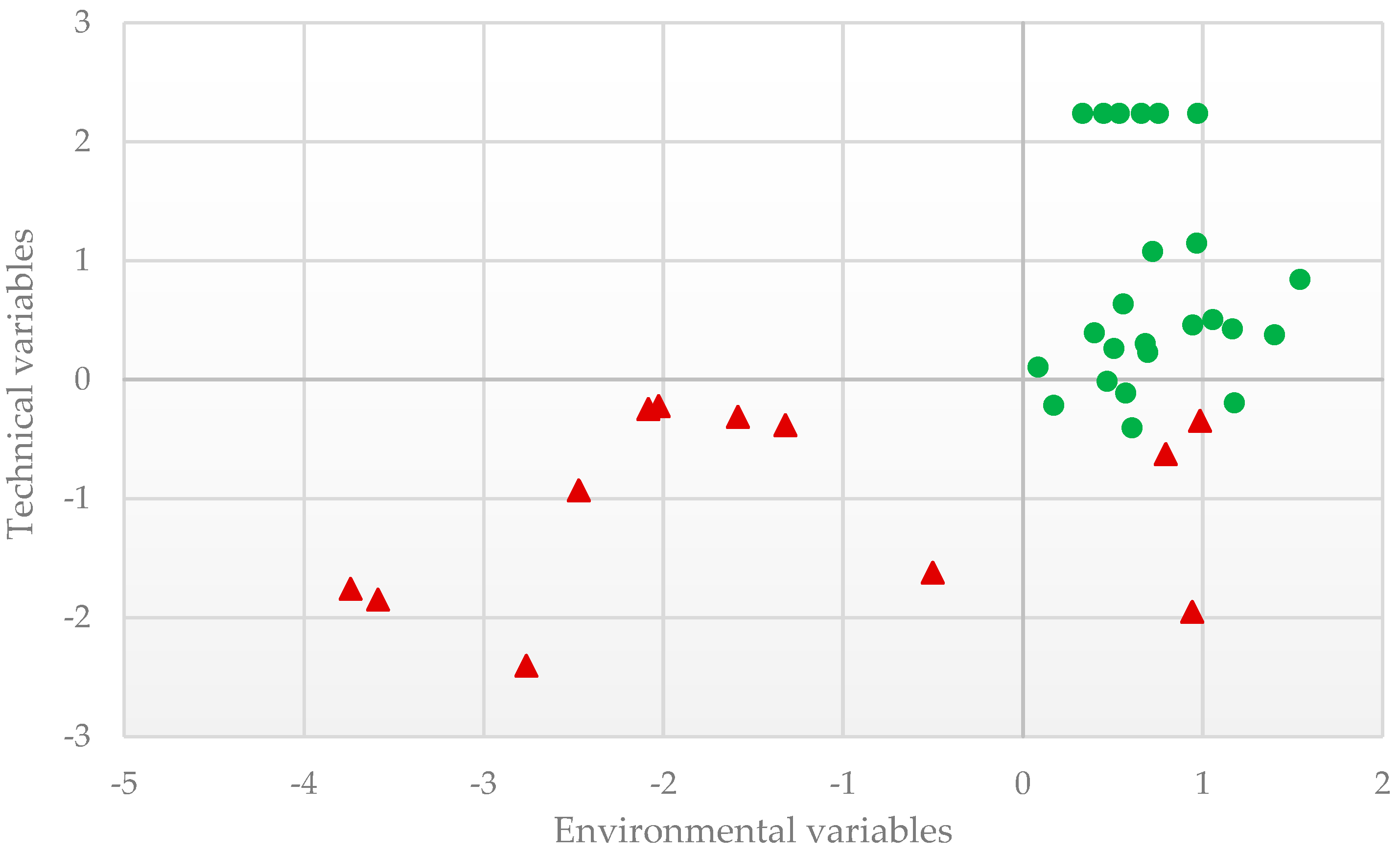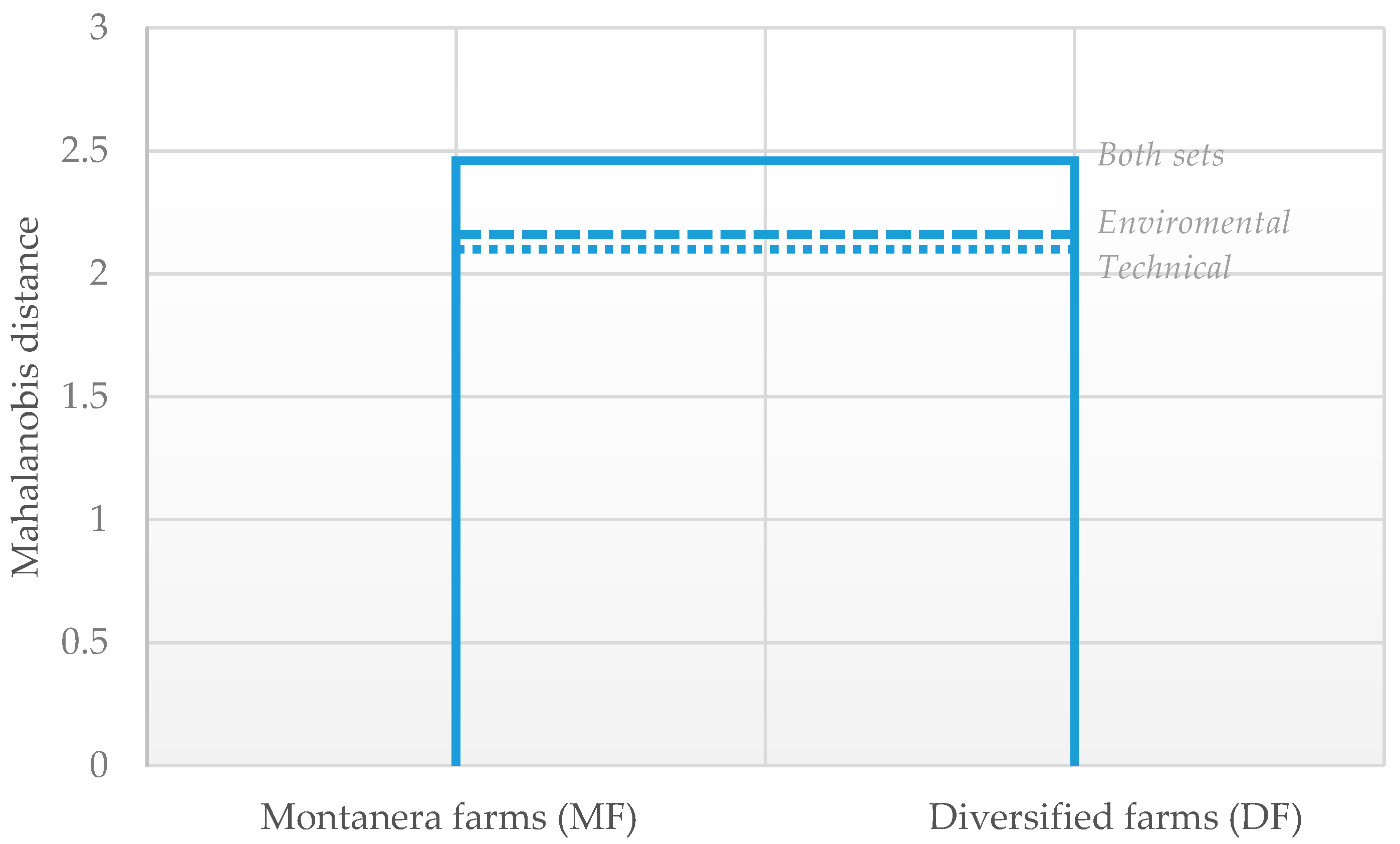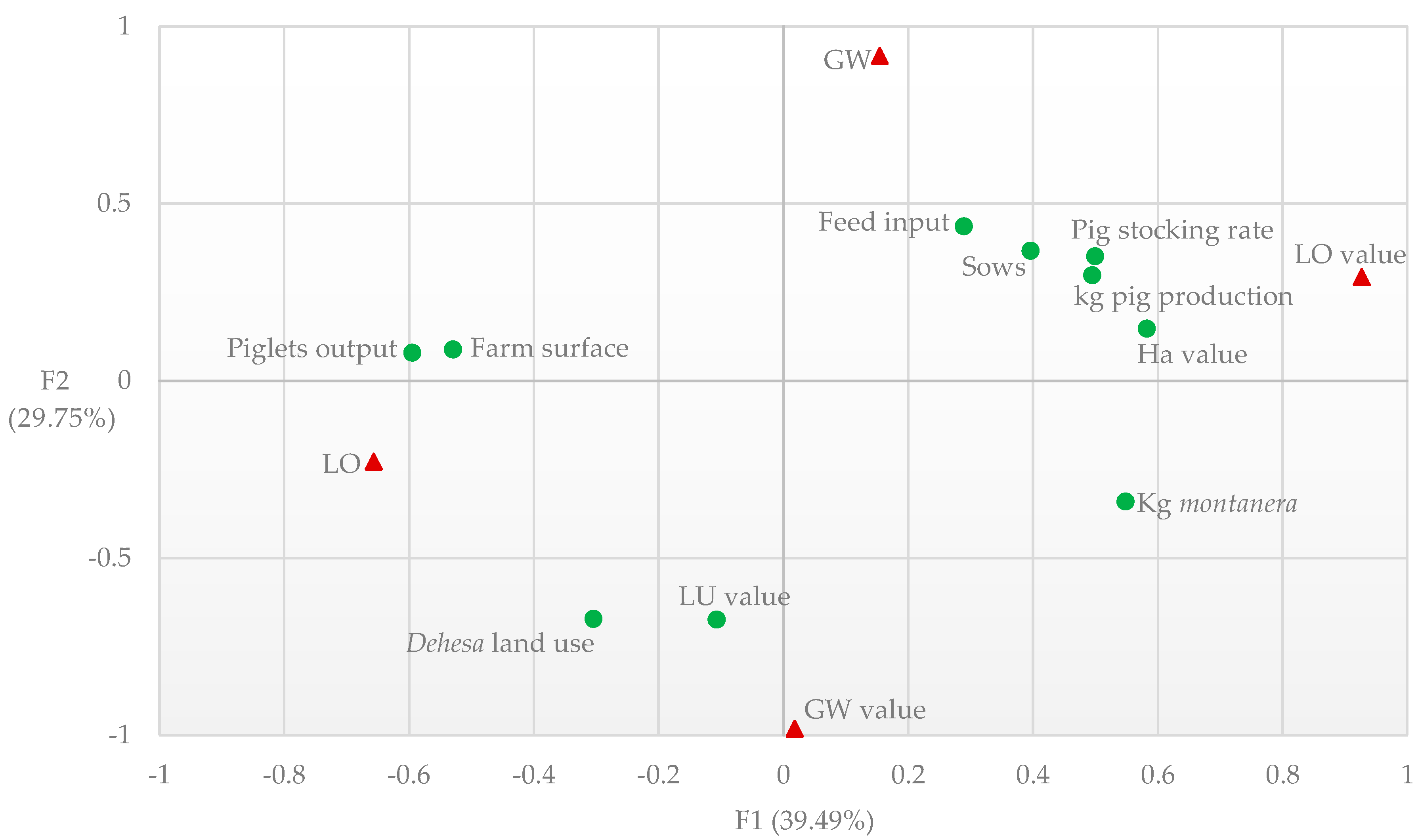Analysis of the Sustainability of Fattening Systems for Iberian Traditional Pig Production through a Technical and Environmental Approach
Abstract
Simple Summary
Abstract
1. Introduction
2. Materials and Methods
2.1. Description of the Pig Fattening at the Iberian Traditional Pig Production
2.2. Data Acquisition
2.3. Statistical Analysis
3. Results and Discussion
3.1. Differentiation of Iberian Fattening Production
3.2. Reference Points in Iberian Fattening Production
3.3. Improvements for More Sustainable Iberian Fattening Production
4. Conclusions
Author Contributions
Funding
Institutional Review Board Statement
Informed Consent Statement
Data Availability Statement
Acknowledgments
Conflicts of Interest
References
- De Miguel, A.; Hoekstra, A.Y.; García-Calvo, E. Sustainability of the water footprint of the Spanish pork industry. Ecol. Indic. 2015, 57, 465–474. [Google Scholar] [CrossRef]
- Gaspar, P.; Mesías, F.J.; Escribano, M.; Pulido, F. Assessing the technical efficiency of extensive livestock farming systems in Extremadura, Spain. Livest. Sci. 2009, 121, 7–14. [Google Scholar] [CrossRef]
- Temple, D.; Manteca, X.; Velarde, A.; Dalmau, A. Assessment of animal welfare through behavioural parameters in Iberian pigs in intensive and extensive conditions. Appl. Anim. Behav. Sci. 2011, 131, 29–39. [Google Scholar] [CrossRef]
- Lorido, L.; Estévez, M.; Ventanas, J.; Ventanas, S. Comparative study between Serrano and Iberian dry-cured hams in relation to the application of high hydrostatic pressure and temporal sensory perceptions. LWT Food Sci. Technol. 2015, 64, 1234–1242. [Google Scholar] [CrossRef]
- García-Gudiño, J.; Monteiro, A.N.T.R.; Espagnol, S.; Blanco-Penedo, I.; Garcia-Launay, F. Life cycle assessment of Iberian traditional pig production system in Spain. Sustainability 2020, 12, 627. [Google Scholar] [CrossRef]
- Rodriguez-Estevez, V.; Sanchez-Rodriguez, M.; Arce, C.; García, A.R.; Perea, J.M.; Gustavo, A. Consumption of Acorns by Finishing Iberian Pigs and Their Function in the Conservation of the Dehesa Agroecosystem. In Book Agroforestry for Biodiversity and Ecosystem Services—Science and Practice; Kaonga, M., Ed.; InTech: Rijeka, Croatia, 2012; pp. 1–22. [Google Scholar] [CrossRef]
- Clark, B.; Panzone, L.A.; Stewart, G.B.; Kyriazakis, I.; Niemi, J.K.; Latvala, T.; Jones, P.; Frewer, L.J. Consumer attitudes towards production diseases in intensive production systems. PLoS ONE 2019, 14, e0210432. [Google Scholar] [CrossRef]
- Real Decreto 4/2014, de 10 de Enero, por el Que se Aprueba la Norma de Calidad Para la Carne, el Jamón, la Paleta y la Caña de Lomo Ibérico. Available online: http://www.boe.es/boe/dias/2014/01/11/pdfs/BOE-A-2014-318.pdf (accessed on 20 October 2020).
- Registro Informativo de Organismos Independientes de Control del Ibérico (RIBER). Available online: https://www.mapa.gob.es/es/alimentacion/temas/control-calidad/mesa-iberico/riber-publico/ (accessed on 2 October 2020).
- Ríos-Núñez, S.M.; Coq-Huelva, D. The Transformation of the Spanish Livestock System in the Second and Third Food Regimes. J. Agrar. Chang. 2015, 15, 519–540. [Google Scholar] [CrossRef]
- Mesías, F.J.; Gaspar, P.; Pulido, A.F.; Escribano, M.; Pulido, F. Consumers’ preferences for Iberian dry-cured ham and the influence of mast feeding: An application of conjoint analysis in Spain. Meat Sci. 2009, 83, 684–690. [Google Scholar] [CrossRef]
- Lopez-Bote, C.J. Sustained utilization of the Iberian pig breed. Meat Sci. 1998, 49, 17–27. [Google Scholar] [CrossRef]
- Casas, J.J.; Bonachela, S.; Moyano, F.J.; Fenoy, E.; Hernández, J. Agricultural Practices in the Mediterranean: A Case Study in Southern Spain. In Book the Mediterranean; Preedy, V.R., Watson, R.R., Eds.; Academic Press: Cambridge, MA, USA, 2015; pp. 23–36. [Google Scholar] [CrossRef]
- Ibáñez, J.; Contador, J.F.L.; Schnabel, S.; Fernández, M.P.; Valderrama, J.M. A model-based integrated assessment of land degradation by water erosion in a valuable Spanish rangeland. Environ. Model. Softw. 2014, 55, 201–213. [Google Scholar] [CrossRef]
- López-Sánchez, A.; Schroeder, J.; Roig, S.; Sobral, M.; Dirzo, R. Effects of cattle management on oak regeneration in northern Californian Mediterranean oak woodlands. PLoS ONE 2014, 9, e105472. [Google Scholar] [CrossRef]
- Dolman, M.A.; Vrolijk, H.C.J.; De Boer, I.J.M. Exploring variation in economic, environmental and societal performance among Dutch fattening pig farms. Livest. Sci. 2012, 149, 143–154. [Google Scholar] [CrossRef]
- Horrillo, A.; Gaspar, P.; Mesiás, F.J.; Elghannam, A.; Escribano, M. Understanding the barriers and exploring the possibilities of the organic livestock sector in dehesa agroforestry systems: A multi-actor approach for effective diagnosis. Renew. Agric. Food Syst. 2019, 35, 663–677. [Google Scholar] [CrossRef]
- Asmild, M.; Hougaard, J.L. Economic versus environmental improvement potentials of Danish pig farms. Agric. Econ. 2006, 35, 171–181. [Google Scholar] [CrossRef]
- Gaspar, P.; Mesías, F.J.; Escribano, M.; Rodriguez-Ledesma, A.; Pulido, F. Economic and management characterization of dehesa farms: Implications for their sustainability. Agrofor. Syst. 2007, 71, 151–162. [Google Scholar] [CrossRef]
- Gaspar, P.; Mesías, F.J.; Escribano, M.; Pulido, F. Sustainability in Spanish extensive farms (Dehesas): An economic and management indicator-based evaluation. Rangel. Ecol. Manag. 2009, 62, 153–162. [Google Scholar] [CrossRef]
- Horrillo, A.; Gaspar, A.; Escribano, M. Organic farming as a strategy to reduce carbon footprint in dehesa agroecosystems: A case study comparing different livestock products. Animals 2020, 10, 162. [Google Scholar] [CrossRef]
- Horrillo, A.; Gaspar, P.; Díaz-Caro, C.; Escribano, M. A scenario-based analysis of the effect of carbon pricing on organic livestock farm performance: A case study of Spanish dehesas and rangelands. Sci. Total Environ. 2021, 751, 141675. [Google Scholar] [CrossRef]
- Nieto, R.; García-Casco, J.; Lara, L.; Palma-Granados, P.; Izquierdo, M.; Hernandez, F.; Dieguez, E.; Duarte, J.L.; Batorek-Lukac, N. Ibérico (Iberian) Pig. In Book European Local Pig Breeds—Diversity and Performance A Study of Project TREASURE; Candek-Potokar, M., Nieto, R., Eds.; InTech: Rijeka, Croatia, 2019; pp. 1–25. [Google Scholar] [CrossRef]
- Olea, L.; Paredes, J.; Verdasco, M.P. Características y producción de los pastos de las dehesas del SO de la Península Ibérica. Pastos 1990, 21, 131–156. [Google Scholar]
- Jäntschi, L. A test detecting the outliers for continuous distributions based on the cumulative distribution function of the data being tested. Symmetry 2019, 11, 835. [Google Scholar] [CrossRef]
- Caballero-Villalobos, J.; Figueroa, A.; Xibrraku, K.; Angón, E.; Perea, J.M.; Garzón, A. Multivariate analysis of the milk coagulation process in ovine breeds from Spain. J. Dairy Sci. 2018, 101, 10733–10742. [Google Scholar] [CrossRef]
- Rivas, J.; Perea, J.M.; De Pablos-Heredero, C.; Angon, E.; Barba, C.; García, A. Canonical correlation of technological innovation and performance in sheep’s dairy farms: Selection of a set of indicators. Agric. Syst. 2019, 176, 102665. [Google Scholar] [CrossRef]
- Figueroa, A.; Caballero-Villalobos, J.; Angón, E.; Arias, R.; Garzón, A.; Perea, J.M. Using multivariate analysis to explore the relationships between color, composition, hygienic quality, and coagulation of milk from Manchega sheep. J. Dairy Sci. 2020, 103, 4951–4957. [Google Scholar] [CrossRef]
- Zurita-Herrera, P.; Delgado, J.V.; Argüello, A.; Camacho, M.E. Multivariate analysis of meat production traits in Murciano-Granadina goat kids. Meat Sci. 2011, 88, 447–453. [Google Scholar] [CrossRef]
- Miles, A.; Perea Muñoz, J.M.; Bayle-Sempere, J.T. Low satisfaction and failed relational coordination among relevant stakeholders in Spanish Mediterranean marine protected areas. J. Environ. Manag. 2020, 272, 111003. [Google Scholar] [CrossRef]
- De Maesschalck, R.; Jouan-Rimbaud, D.; Massart, D.L. The Mahalanobis distance. Chemom. Intell. Lab. Syst. 2000, 50, 1–18. [Google Scholar] [CrossRef]
- Mardia, K.V.; Bookstein, F.L.; Moreton, I.J. Statistical assessment of bilateral symmetry of shapes. Biometrika 2000, 87, 285–300. [Google Scholar] [CrossRef]
- Tabachnick, B.G.; Fidell, L.S. Using Multivariate Statistics, 7th ed.; Pearson: New York, NY, USA, 2019. [Google Scholar]
- Yin, X. Canonical correlation analysis based on information theory. J. Multivar. Anal. 2004, 91, 161–176. [Google Scholar] [CrossRef]
- Liu, J.; Drane, W.; Liu, X.; Wu, T. Examination of the relationships between environmental exposures to volatile organic compounds and biochemical liver tests: Application of canonical correlation analysis. Environ. Res. 2009, 109, 193–199. [Google Scholar] [CrossRef]
- Zucali, M.; Lovarelli, D.; Celozzi, S.; Bacenetti, J.; Sandrucci, A.; Bava, L. Management options to reduce the environmental impact of dairy goat milk production. Livest. Sci. 2020, 231, 103888. [Google Scholar] [CrossRef]
- Espagnol, S.; Demartini, J. Environmental impacts of extensive outdoor pig production systems in Corsica. In Proceedings of the 9th International Conference on Life Cycle Assessment in the Agri-Food Sector (LCA Food 2014), San Francisco, CA, USA, 8–10 October 2014; pp. 364–371. [Google Scholar]
- Monteiro, A.N.T.R.; Wilfart, A.; Utzeri, V.J.; Lukac, N.B.; Tomazin, U.; Costa, L.N.; Candek-Potokar, M.; Fontanesi, L.; Garcia-Launay, F. Environmental impacts of pig production systems using European local breeds: The contribution of carbon sequestration and emissions from grazing. J. Clean. Prod. 2019, 237, 117843. [Google Scholar] [CrossRef]
- Szyndler-Nędza, M.; Małopolska, M.; Nowicki, J. The production system of high quality pork products—An example. Ann. Warsaw Univ. Life Sci. SGGW Anim. Sci. 2019, 58, 181–198. [Google Scholar] [CrossRef]
- Faure, J.; Brossard, L.; Garcia-Launay, F.; Gil, M.; Kallas, Z.; Gil, J.M. A qualitative and participative approach to analyse different strategies of valorization of Noir de Bigorre pork chain. In Proceedings of the X International Symposium of Mediterranean Pig, Florence, Italy, 16–18 October 2019. [Google Scholar]
- Benito, J.; Albarrán, A.; García-Casco, J.M. Extensive Iberian pig production grazing systems. In Proceedings of the 21st General Meeting of the European Grassland Federation, Badajoz, Spain, 3–6 April 2006; pp. 635–645. [Google Scholar]
- Martin, G.; Barth, K.; Benoit, M.; Brock, C.; Destruel, M.; Dumont, B.; Grillot, M.; Hübner, S.; Magne, M.A.; Moerman, M.; et al. Potential of multi-species livestock farming to improve the sustainability of livestock farms: A review. Agric. Syst. 2020, 181, 102821. [Google Scholar] [CrossRef]
- Dourmad, J.Y.; Ryschawy, J.; Trousson, T.; Bonneau, M.; González, J.; Houwers, H.W.J.; Hviid, M.; Zimmer, C.; Nguyen, T.L.T.; Morgensen, L. Evaluating environmental impacts of contrasting pig farming systems with life cycle assessment. Animal 2014, 8, 2027–2037. [Google Scholar] [CrossRef]
- González-García, S.; Belo, S.; Dias, A.C.; Rodrigues, J.V.; Da Costa, R.R.; Ferreira, A.; De Andrade, L.P.; Arroja, L. Life cycle assessment of pigmeat production: Portuguese case study and proposal of improvement options. J. Clean. Prod. 2015, 100, 126–139. [Google Scholar] [CrossRef]
- Cadéro, A.; Aubry, A.; Dourmad, J.Y.; Salaün, Y.; Garcia-Launay, F. Effects of interactions between feeding practices, animal health and farm infrastructure on technical, economic and environmental performances of a pig-fattening unit. Animal 2020, 14, S348–S359. [Google Scholar] [CrossRef]
- Quintern, M. Integration of organic pig production within crop rotation: Implications on nutrient losses. In Book Organic Pig Production in Free Range Systems; Sundrum, A., Weibmann, F., Eds.; Institute of Organic Farming: Braunschweig, Germany, 2005; pp. 31–41. [Google Scholar]
- Gil, A.; Llera, F.; García-Calvo, A.; Rufo, S. Nuevas oportunidades de alimentación en la dehesa: El Triticale. In Book la Agricultura y la Ganadería Extremeñas; Publisher: Badajoz, Spain, 2008; pp. 173–189. [Google Scholar]
- Van Der Werf, H.M.G.; Petit, J.; Sanders, J. The environmental impacts of the production of concentrated feed: The case of pig feed in Bretagne. Agric. Syst. 2005, 83, 153–177. [Google Scholar] [CrossRef]
- Mackenzie, S.G.; Leinonen, I.; Ferguson, N.; Kyriazakis, I. Can the environmental impact of pig systems be reduced by utilising co-products as feed? J. Clean. Prod. 2016, 115, 172–181. [Google Scholar] [CrossRef]
- Ali, B.M.; van Zanten, H.H.E.; Berentsen, P.; Bastiaansen, J.W.M.; Bikker, P.; Lansink, A.O. Environmental and economic impacts of using co-products in the diets of finishing pigs in Brazil. J. Clean. Prod. 2017, 162, 247–259. [Google Scholar] [CrossRef]
- Baldinger, L.; Hagmüller, W.; Minihuber, U.; Matzner, M.; Zollitsch, W. Sainfoin seeds in organic diets for weaned piglets—Utilizing the protein-rich grains of a long-known forage legume. Renew. Agric. Food Syst. 2014, 31, 12–21. [Google Scholar] [CrossRef]
- Van Zanten, H.H.E.; Bikker, P.; Meerburg, B.G.; De Boer, I.J.M. Attributional versus consequential life cycle assessment and feed optimization: Alternative protein sources in pig diets. Int. J. Life Cycle Assess. 2018, 23, 1–11. [Google Scholar] [CrossRef]
- Florou-Paneri, P.; Christaki, E.; Giannenas, I.; Bonos, E.; Skoufos, I.; Tsinas, A.; Tzora, A.; Peng, J. Alternative protein sources to soybean meal in pig diets. J. Food Agric. Environ. 2014, 12, 655–660. [Google Scholar]



| Requirements Fattening Period | Montanera | Cebo de Campo |
|---|---|---|
| Feeding | Natural resources (acorn and grass) | Compound feed and natural resources (grass) |
| Stocking density | 0.25–1.25 animals/ha | 15 animals/ha |
| Minimum duration | 60 days | 60 days |
| Minimum age at slaughter | 14 months | 12 months |
| Variable | Description | Mean | SE 1 |
|---|---|---|---|
| Technical variables | |||
| Farm surface | Total surface area, ha | 631.60 | 104.02 |
| Dehesa land use | Utilized dehesa area/Total dehesa area, % | 79.25 | 5.34 |
| Pig stocking rate | Pig livestock unit per ha, LU/ha | 0.12 | 0.02 |
| Sows | Sows per 100 kg of pig | 0.16 | 0.09 |
| Piglets output | Piglets produced per fattened pig | 1.48 | 0.19 |
| kg montanera | kg of live weight from fatteners montanera per dehesa area, kg/ha | 95.70 | 17.21 |
| kg total pig production | kg of live weight from pig production per total surface area, kg/ha | 106.49 | 17.67 |
| ha value * | Production value per ha, €/ha | 298.15 | 43.93 |
| LU value * | Production value per pig livestock unit, €/LU | 2554.4 | 100.69 |
| Feedstuffs inputs | Animal feedstuffs per ha, kg/ha | 212.69 | 92.77 |
| Environmental variables | |||
| GW | Global warming, kg CO2 eq | 3.75 | 0.75 |
| LO | Land occupation CML non baseline, m2·year | 38.72 | 3.60 |
| GW value * | Production value per GW, €/CO2 eq | 0.795 | 0.027 |
| LO value * | Production value per LO, €/m2·year | 0.092 | 0.007 |
| Variable | Montanera Farms (MF) | SE 1 | Diversified Farms (DF) | SE 1 | Wilks’ λ | F-Value | p-Value | CAN 2 |
|---|---|---|---|---|---|---|---|---|
| Technical variables | ||||||||
| Farm surface | 658.6 | 132.4 | 577.7 | 171.9 | 0.996 | 0.13 | 0.720 | 0.088 |
| Dehesa land use * | 87.17 | 4.89 | 63.42 | 11.75 | 0.875 | 4.87 | 0.034 | 0.606 |
| Pig stocking rate | 0.09 | 0.02 | 0.16 | 0.05 | 0.950 | 1.79 | 0.190 | −0.419 |
| Sows * | 0.06 | 0.01 | 0.37 | 0.29 | 0.936 | 2.33 | 0.014 | −0.349 |
| Piglets output | 1.30 | 0.21 | 1.86 | 0.37 | 0.945 | 1.98 | 0.168 | −0.305 |
| kg montanera | 113.5 | 24.36 | 60.02 | 13.13 | 0.939 | 2.22 | 0.145 | 0.339 |
| kg total pig production | 97.06 | 16.07 | 125.4 | 43.02 | 0.984 | 0.56 | 0.458 | −0.371 |
| ha value | 291.2 | 48.71 | 312.1 | 92.05 | 0.999 | 0.49 | 0.826 | −0.346 |
| LU value * | 2825.5 | 72.49 | 2012.0 | 186.3 | 0.586 | 24.06 | <0.001 | 0.962 |
| Feedstuffs inputs | 115.9 | 43.52 | 406.3 | 262.9 | 0.938 | 2.25 | 0.142 | −0.152 |
| Environmental variables | ||||||||
| GW * | 3.41 | 0.05 | 4.44 | 0.27 | 0.570 | 25.66 | <0.001 | −0.953 |
| LO | 43.00 | 4.70 | 30.15 | 4.59 | 0.919 | 3.00 | 0.09 | 0.492 |
| GW value * | 0.88 | 0.01 | 0.63 | 0.06 | 0.486 | 36.00 | <0.001 | 0.989 |
| LO value | 0.09 | 0.01 | 0.11 | 0.01 | 0.951 | 1.76 | 0.193 | −0.376 |
| Model | Variables in the Model | Number of Groups | Wilks’ λ | F-Value | p-Value |
|---|---|---|---|---|---|
| Technical | Sows, Value LU | 2 | 0.474 | 18.30 | <0.001 |
| Environmental | LO, Value GW | 2 | 0.425 | 45.36 | <0.001 |
| Both sets | Value LU, Value GW | 2 | 0.411 | 35.99 | <0.001 |
| Group | Montanera Farms (MF) | Diversified Farms (DF) |
|---|---|---|
| Technical model | ||
| Montanera farms | 95.83 | 4.16 |
| Diversified farms | 41.66 | 58.33 |
| Level of error | 0.18 | 0.13 |
| Prior probability | 0.50 | 0.50 |
| Environmental model | ||
| Montanera farm | 100.00 | 0.00 |
| Diversified farm | 8.33 | 91.66 |
| Level of error | 0.04 | 0.00 |
| Prior probability | 0.50 | 0.50 |
| Both sets of variables | ||
| Montanera farm | 100.00 | 0.00 |
| Diversified farm | 8.33 | 91.66 |
| Level of error | 0.04 | 0.00 |
| Prior probability | 0.50 | 0.50 |
| Factor | Eigen Value | Canonical Correlation | Variability, % | Wilks’ λ | p-Value |
|---|---|---|---|---|---|
| F1 | 0.946 | 0.973 | 39.49 | 0.006 | <0.001 |
| F2 | 0.712 | 0.844 | 29.75 | 0.104 | <0.001 |
| F3 | 0.559 | 0.748 | 23.36 | 0.362 | 0.032 |
| F4 | 0.178 | 0.421 | 7.40 | 0.822 | 0.615 |
Publisher’s Note: MDPI stays neutral with regard to jurisdictional claims in published maps and institutional affiliations. |
© 2021 by the authors. Licensee MDPI, Basel, Switzerland. This article is an open access article distributed under the terms and conditions of the Creative Commons Attribution (CC BY) license (http://creativecommons.org/licenses/by/4.0/).
Share and Cite
García-Gudiño, J.; Blanco-Penedo, I.; Font-i-Furnols, M.; Angón, E.; Perea, J.M. Analysis of the Sustainability of Fattening Systems for Iberian Traditional Pig Production through a Technical and Environmental Approach. Animals 2021, 11, 411. https://doi.org/10.3390/ani11020411
García-Gudiño J, Blanco-Penedo I, Font-i-Furnols M, Angón E, Perea JM. Analysis of the Sustainability of Fattening Systems for Iberian Traditional Pig Production through a Technical and Environmental Approach. Animals. 2021; 11(2):411. https://doi.org/10.3390/ani11020411
Chicago/Turabian StyleGarcía-Gudiño, Javier, Isabel Blanco-Penedo, Maria Font-i-Furnols, Elena Angón, and José Manuel Perea. 2021. "Analysis of the Sustainability of Fattening Systems for Iberian Traditional Pig Production through a Technical and Environmental Approach" Animals 11, no. 2: 411. https://doi.org/10.3390/ani11020411
APA StyleGarcía-Gudiño, J., Blanco-Penedo, I., Font-i-Furnols, M., Angón, E., & Perea, J. M. (2021). Analysis of the Sustainability of Fattening Systems for Iberian Traditional Pig Production through a Technical and Environmental Approach. Animals, 11(2), 411. https://doi.org/10.3390/ani11020411









